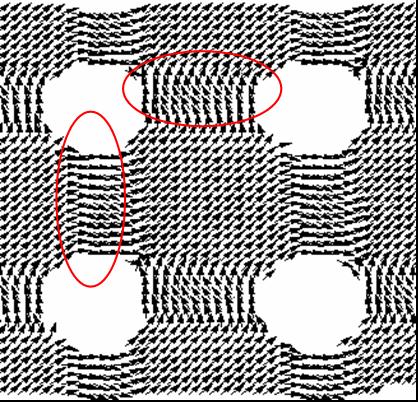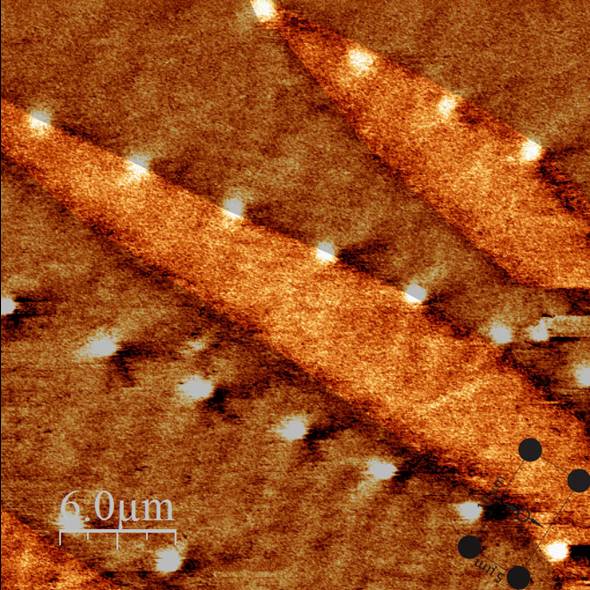A type of nanostructure made available by the current microfabrication
techniques is the inclusion of an array of nonmagnetic regions (holes)
defined within a magnetic thin film (see Fig. 5.1).
These
magnetic elements are known, in opposition to dots, as antidots.
The magnetic thin film
dipolar energy associated with the magnetic poles
present at the surfaces of the array motifs
can override the magnetocrystalline anisotropy and largely determine
the global demagnetization of the system. Hence, the coercivity of the
antidot film can present a substantial increase compared to that of a
continuous film. Additionally, the symmetry of the array determines
that of the induced magnetic anisotropy, for example square and
hexagonal arrays give respectively fourfold and sixfold anisotropies [Wang 06].
The use of different lithographic techniques, which include electron
beam [Adeyeye 97],
ultra-violet [Wang 06], focused
ionic beam [Toporov 00], x-ray
[Ruiz-Feal 02] or
interferometric lithography [Vavassori 99],
and
anodic aluminium oxide membranes [Xiao 02]
makes
possible to fabricate highly regular antidot arrays with antidot
sizes and interantidot distances with values going from a few tens of  up to the units of
up to the units of  .
The imprinted motifs found in the literature are square [Heyderman 06], rectangular [Wang 04], elliptical [Guedes 00] and circular [Ruiz-Feal 02] holes. The
techniques that allow to systematically vary the geometrical parameters
(i.e size, shape and symmetry) and the dependence of the magnetic
behavior on such parameters open the interesting possibility of
tayloring the coercivity.
.
The imprinted motifs found in the literature are square [Heyderman 06], rectangular [Wang 04], elliptical [Guedes 00] and circular [Ruiz-Feal 02] holes. The
techniques that allow to systematically vary the geometrical parameters
(i.e size, shape and symmetry) and the dependence of the magnetic
behavior on such parameters open the interesting possibility of
tayloring the coercivity.
Figure 5.1:
SEM image of an antidot Fe film from the Ph. D. thesis of J.M. Torres [Torres 05].
|
|
Figure 5.2:
Magnetization distribution in closely packed antidot film. The circles
indicate where the bits would be stored in the proposal of magnetic
recording in Ref. [Cowburn 97].
|
|
Besides the engineering of the coercivity, the use of antidots arrays
has been suggested for
magnetic recording applications. The antidots films have been proposed
as potential recording media, where the bits are stored in the
interantidot region [Cowburn 97]
(see
Fig. 5.2). This
implementation is favored by the absence of any superparamagnetic
effect, due to the large volume that is relatively strongly coupled,
compared to the set of nearly isolated grains that constitute
conventional media.
The main disadvantage of the use of antidots arrays is linked to the
potentially high noise-to-signal ratio originated by the bit
transition, which should have in these arrays a width of the order of
the material exchange correlation length [Jalil 03].
In
fact,
the potential recording media in order to be promising enough
have to be not obsolete compared with the current technology when the
candidate would reach production stages.
Another proposal for the use of such structures is the Percolated
Perpendicular Media [Zhu 07]. The
medium consists of exchange coupled grains and densely
distributed nonmagnetic columns (antidots). The non-magnetic inclusions
act as pinning centers and yield smooth transition boundaries, thus
reducing transition noise while the thermal stability is not degraded.
Another possible application
is related to the implementation of different types of
stress and magnetic field sensing devices for which the occurrence
of reversible magnetization variations in large field ranges
is desirable [Gonzalez 05].
Figure:
(a) MFM image of an antidot Fe film in the concentrated regime from the
Ph. D. thesis of J.M. Torres [Torres 05].
(b)
MFM image of a  film patterned with circular
holes where the pinning of the domain wall by the line of antidots is
observed (from G. Rodríguez Rodríguez of the Universidad
de Oviedo).
film patterned with circular
holes where the pinning of the domain wall by the line of antidots is
observed (from G. Rodríguez Rodríguez of the Universidad
de Oviedo).
|
|
|
|
Regarding the relation between the density of antidots and the
magnetic behavior of the thin film, we can clearly distinguish two
extreme regimes:
- Concentrated regime. The antidots are close enough that the
magnetization structures that are created by the antidot surface occupy
the antidot region and create a highly inhomogeneous domain structure
(the antidots ``interact'', see Figs. 5.2
and 5.3(a) ). The magnetic anisotropy is
dominated by the induced anisotropy resulting from the spatial
preference of the created structure.
- Diluted regime. In this regime the antidots are far enough to be
considered isolated and do not appreciably alter the magnetic
anisotropy as can be observed in Fig. 5.4.
The
effect of the dots is to act as pinning centers for the domain
walls propagating through the sample, which is shown in Fig. 5.3(b) [Pérez-Junquera 06].
The length of the magnetic structures created around the antidots is
determined by the exchange length in the considered material.
Therefore, in the diluted region the separation between antidots is
several times larger than this quantity.
Figure:
MFM image of a  film patterned with circular
holes extracted from the Ref. [Pérez-Junquera 06].
film patterned with circular
holes extracted from the Ref. [Pérez-Junquera 06].
|
|
One of the main problems raised by the patterned
films is that related to the understanding of their demagnetization
processes and, especially, the relationship between those processes
and the array geometry and dimensions. Due to the dipolar energy
minimizing structures at the antidots surfaces, the films can
exhibit significant spatial inhomogeneities in the magnetic moment
distribution, which can largely influence the global behavior of the
system and make difficult the description in simple terms of the
magnetization reversal. In this chapter we will analyze the
magnetization reversal in patterned films on the basis of a comparison
between the micromagnetic simulations and the experimentally measured
coercivity in Fe antidots films.
2008-04-04
![]() up to the units of
up to the units of ![]() .
The imprinted motifs found in the literature are square [Heyderman 06], rectangular [Wang 04], elliptical [Guedes 00] and circular [Ruiz-Feal 02] holes. The
techniques that allow to systematically vary the geometrical parameters
(i.e size, shape and symmetry) and the dependence of the magnetic
behavior on such parameters open the interesting possibility of
tayloring the coercivity.
.
The imprinted motifs found in the literature are square [Heyderman 06], rectangular [Wang 04], elliptical [Guedes 00] and circular [Ruiz-Feal 02] holes. The
techniques that allow to systematically vary the geometrical parameters
(i.e size, shape and symmetry) and the dependence of the magnetic
behavior on such parameters open the interesting possibility of
tayloring the coercivity.

![\includegraphics[height=6.0cm]{Capitulo5/Graficas5/mfm}](img721.gif)

![\includegraphics[height=6.cm]{Capitulo5/Graficas5/mfmoviedo}](img722.gif)